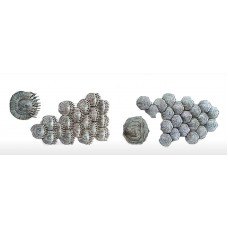Three forms of scales are distinguished: placoid, ganoid, and bony.
Bony scales are rounded bony plates devoid of the upper layer of ganoin. Hard hyalodentine layer lies on the surface of scales, there are irregularities in the form of concentric rolls - sclerites. Scales are arranged tile-shaped, the anterior edge of a scale lies in a scale pocket, the posterior edge is free, under it there is a scale pocket of the next scale. Bony scales are of two types: ctenoid and cycloid.
Over time, the scales lost their ganoin. In modern bony fish ganoin is no longer ganoin, scales consist of bone plates. These scales can be: cycloid - round, with smooth edges (carp) and ctenoid - with a jagged back edge (perch). Both forms are related, but cycloid as more primitive is found in low-organized fishes. Sometimes, within the same species, males have ctenoid and females - cycloid scales (flounders of the genus Liopsetta), or even in one individual there are scales of both forms.
Bony scales
Tags: bony scales


